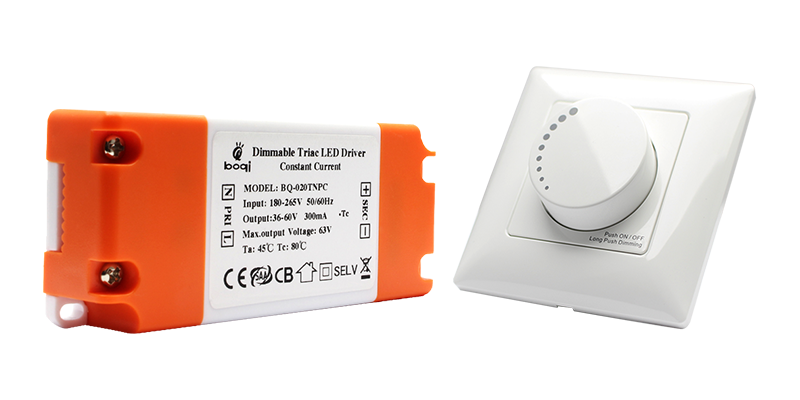
Tasaisen ja säädettävän kirkkauden saavuttaminen LED-valaistuksessa voi olla haastavaa. LED-ajureilla on ratkaiseva rooli tämän ongelman ratkaisemisessa, sillä ne säätelevät sähkötehoa kirkkauden säätämiseksi. Tässä oppaassa tutustumme menetelmiin, joita LED-ajurit käyttävät optimaalisen kirkkauden säädön varmistamiseksi.
LED-ajurit säätelevät LEDien kirkkautta säätämällä niihin syötettävää sähkötehoa pääasiassa kahdella menetelmällä: Pulssinleveysmodulaatio (PWM) ja virran vähentäminen (analoginen himmennys). Nämä tekniikat mahdollistavat tarkan ja tehokkaan kirkkauden säädön samalla kun LEDien käyttöikä ja suorituskyky säilyvät.
Tutustutaan tarkemmin siihen, miten nämä tekniikat toimivat ja miksi ne ovat olennaisia LED-valaistusjärjestelmissä.
Mikä on LED-ohjain?
LED-ajurit ovat LED-valaistuksen laulamattomia sankareita. Ne muuttavat sähkövirran muotoon, jota LEDit voivat käyttää turvallisesti.
LED-ajurit säätelevät virtaa varmistaakseen tasaisen kirkkauden ja suojatakseen LEDit vaihtelevien virtalähteiden aiheuttamilta vaurioilta.
!
Miksi LED-ohjaimet ovat välttämättömiä?
LEDit vaativat tarkkaa virranhallintaa ylikuumenemisen estämiseksi ja tasaisen kirkkauden varmistamiseksi. Ilman LED-ohjainta LEDit voivat joko välkkyä tai palaa ennenaikaisesti loppuun. Ajurit eivät ainoastaan tarjoa vakaata virtaa, vaan mahdollistavat myös himmennystoiminnot.
| LED-ajureiden keskeinen rooli | Kuvaus |
|---|---|
| Tehon muuntaminen | Muuntaa vaihtovirran tasavirraksi LEDien toimintaa varten. |
| Nykyinen asetus | Estää yli- tai aliohjauksen. |
| Himmennysohjaus | Ottaa käyttöön säädettävän kirkkauden. |
Hallitsemalla näitä seikkoja LED-ajurit varmistavat LED-järjestelmien pitkäikäisyyden ja suorituskyvyn.
Miksi LEDien kirkkauden säätö?
Kirkkauden säätö on muutakin kuin pelkkä mukavuus. Se palvelee useita käytännön tarkoituksia.
LED-valojen himmentäminen vähentää energiankulutusta, parantaa tunnelmaa, vähentää silmien rasitusta ja pidentää valaistusjärjestelmän käyttöikää.
LED-valaistusvoimakkuuden säätöjen sovellukset
Kirkkauden säätö on kriittinen ominaisuus eri tilanteissa älykodeista ammattimaisiin näyttämövalaistuksiin:
- Energiansäästöt: Kirkkauden pienentäminen vähentää sähkönkulutusta.
- Tunnelman luominen: Säädettävä valaistus luo tunnelmia ja asetuksia erilaisiin ympäristöihin.
- Ammattikäyttöön: Teatterit ja studiot luottavat tarkkaan himmennykseen dramaattisten vaikutusten aikaansaamiseksi.
Olipa kyseessä sitten viihtyisä olohuone tai huipputekninen konferenssisali, kirkkauden säätö tarjoaa vertaansa vailla olevaa joustavuutta ja toiminnallisuutta.
LED-ajureiden käyttämät menetelmät kirkkauden säätöön
LED-ajurit käyttävät kahta ensisijaista tekniikkaa kirkkauden säätämiseen: Pulssinleveysmodulaatio (PWM) ja Analoginen himmennys (virran vähennys).
Miten PWM toimii?
Pulssinleveysmodulaatio säätelee kirkkautta kytkemällä LEDin nopeasti päälle ja pois päältä. Kirkkaustaso riippuu työjaksosta - sen ajan osuudesta, jonka LED pysyy päällä kunkin jakson aikana.
PWM tarjoaa tarkan ohjauksen vaikuttamatta LEDin elinikään. Matalataajuinen PWM voi kuitenkin aiheuttaa välkkymistä.

PWM:n edut
- Korkea tarkkuus ja valvonta.
- Vähäinen vaikutus LEDien suorituskykyyn.
- Yhteensopivuus eri sovellusten kanssa.
PWM:n haasteet
- Matalilla taajuuksilla välkkyminen voi rasittaa silmiä.
- Vaatii laadukkaan ohjaimen, jotta toiminta olisi sujuvaa.
| PWM yhdellä silmäyksellä | Yksityiskohdat |
|---|---|
| Kirkkauden säätö | Säätää työjaksoa. |
| Edut | Tarkka, tehokas, ei värisiirtymiä. |
| Huomioita | Välkyntä matalilla taajuuksilla. |
Mikä on analoginen himmennys?
Analoginen himmennys säätää kirkkautta vähentämällä LEDin läpi kulkevaa virtaa. Kirkkaus muuttuu lineaarisesti virran mukaan.
Analoginen himmennys on helppo toteuttaa ja se poistaa välkkymisen, mutta se voi johtaa energiatehokkuuden heikkenemiseen ja mahdollisiin värinmuutoksiin.

Analogisen himmennyksen edut
- Helppo toteuttaa minimaalisilla komponenteilla.
- Ei välkkymisongelmia, ei edes pienemmillä kirkkaustasoilla.
Analogisen himmennyksen haitat
- Tehoton pienemmällä kirkkaudella jatkuvan tehohäviön vuoksi.
- Voi aiheuttaa vähäisiä värivaihteluita, erityisesti tietyillä LED-tyypeillä.
| Analoginen himmennys yhdellä silmäyksellä | Yksityiskohdat |
|---|---|
| Kirkkauden säätö | Vähentää virtaa lineaarisesti. |
| Edut | Yksinkertainen, välkkymätön. |
| Haasteet | Tehokkuuden menetys, mahdolliset siirtymät. |
PWM- ja analogisen himmennyksen vertailu
Sekä PWM- että analogisella himmennyksellä on omat vahvuutensa ja heikkoutensa. Oikean menetelmän valinta riippuu sovelluksesta ja vaatimuksista.
PWM on ihanteellinen skenaarioihin, joissa vaaditaan tarkkuutta ja energiatehokkuutta, kun taas analoginen himmennys soveltuu sovelluksiin, joissa välkkymistä on vältettävä.
| Ominaisuus | PWM | Analoginen himmennys |
|---|---|---|
| Tarkkuus | Korkea tarkkuus työjaksojen kautta. | Rajoittuu nykyisiin mukautuksiin. |
| Energiatehokkuus | Korkea, erityisesti alhaisella kirkkaudella. | Kohtalainen, energian menetys. |
| Sovellukset | Älykkäät kodit, ammattilaisasennukset. | Yksinkertaiset asennukset, perusasetukset. |
Miten älykkäät LED-ohjaimet mahdollistavat kehittyneen kirkkauden hallinnan
Älykkäiden LED-ajureiden tulo on mullistanut kirkkaudensäädön ja integroinut digitaalisia järjestelmiä, kuten DALI (Digitaalinen osoitteellinen valaistusliitäntä) ja IoT-teknologiat.
Älykkäät ohjaimet mahdollistavat dynaamisen ohjauksen sovelluksissa, kuten älykodeissa, toimistoissa ja ulkovalaistuksessa, ja parantavat joustavuutta ja käyttäjäkokemusta.
Smart LED -ajureiden tärkeimmät ominaisuudet
- Digitaaliset rajapinnat: Integroituu saumattomasti järjestelmiin, kuten DALI ja Zigbee.
- Dynaamiset säädöt: Säätää kirkkautta automaattisesti ajan tai käytön mukaan.
- Etäkäyttö: Hallitse valaistusta älypuhelimista tai ohjauskeskuksista.
| Teknologia | Edut |
|---|---|
| DALI | Tarkka ryhmäohjaus. |
| Zigbee | Langaton integrointi. |
| IoT-integraatio | Automaatio ja etäkäyttö. |
Älykkäät LED-ohjaimet eivät ainoastaan yksinkertaista käyttöä vaan myös lisäävät valaistusjärjestelmiin älykkyyden.
Kirkkauden säätöön liittyvät haasteet
Ledien kirkkauden säätäminen ei ole täysin ongelmatonta. Yleisiä ongelmia ovat välkkyminen, ohjaimen yhteensopimattomuus ja lämmönhallinta.
Näitä haasteita voidaan lieventää valitsemalla laadukkaat ohjaimet ja varmistamalla asianmukainen asennus.
Yhteiset haasteet ja ratkaisut
| Haaste | Ratkaisu |
|---|---|
| Flickering | Käytä korkealaatuisia PWM-ajureita. |
| Ajurin yhteensopimattomuus | Sovita ohjaimen tekniset tiedot. |
| Lämmönhallinta | Varmista asianmukainen ilmanvaihto. |
Asianmukaisella suunnittelulla ja oikeilla komponenteilla voidaan ratkaista nämä ongelmat ja varmistaa sujuva ja luotettava toiminta.
Käytännön vinkkejä oikean LED-ohjaimen valintaan himmennystä varten
Oikean LED-ohjaimen valinta on ratkaisevan tärkeää kirkkauden tehokkaan hallinnan kannalta. Ota huomioon nämä avaintekijät:
- Himmennysalue: Valitse ohjain, joka vastaa haluamaasi kirkkaustasoa.
- Yhteensopivuus: Varmista, että ohjain toimii nykyisessä järjestelmässäsi.
- Teholuokitus: Sovita ohjaimen kapasiteetti LED-kuormaan.
| Tekniset tiedot | Merkitys |
|---|---|
| Himmennysalue | Varmistaa halutut kirkkaustasot. |
| Yhteensopivuus | Ehkäisee yhteensopimattomuusongelmia. |
| Teholuokitus | Vältetään vajaatehoiset järjestelmät. |
Arvioimalla näitä näkökohtia voit löytää ohjaimen, joka vastaa tarpeitasi ja takaa optimaalisen suorituskyvyn.
Johtopäätös
LED-ajurit ovat tehokkaan kirkkauden säädön ytimessä, ja ne käyttävät PWM- ja analogista himmennystä johdonmukaisen ja säädettävän valaistuksen aikaansaamiseksi. Näiden tekniikoiden ja niiden sovellusten ymmärtäminen auttaa valitsemaan parhaan ratkaisun erilaisiin tarpeisiin energiansäästöstä tunnelman luomiseen.













